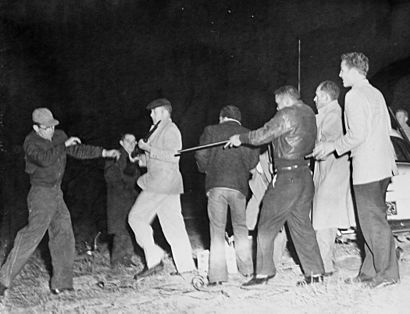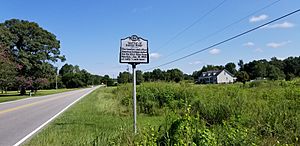Battle of Hayes Pond facts for kids
Quick facts for kids Battle of Hayes Pond |
||||
|---|---|---|---|---|

Lumbee Indians fighting Ku Klux Klansmen during the incident
|
||||
| Date | January 18, 1958 | |||
| Location |
Near Maxton, North Carolina, United States
34°43′07″N 79°21′57″W / 34.71862366859941°N 79.36573253796487°W |
|||
| Caused by | Ku Klux Klan cross burnings and racist threats against the Lumbee community | |||
| Resulted in | Klan rally disrupted | |||
| Parties to the civil conflict | ||||
|
||||
| Lead figures | ||||
|
||||
| Number | ||||
|
||||
| Casualties | ||||
| Injuries | 4 Klansmen injured by gunfire; 3 journalists and 1 witness injured | |||
| Arrested | 1 Klansman arrested by police | |||
The Battle of Hayes Pond (also called the Battle of Maxton Field or the Maxton Riot) was a clash between members of the Ku Klux Klan (KKK) and Lumbee Indians. It happened near Maxton, North Carolina, on the night of January 18, 1958. The event stopped the KKK rally. News reports widely praised the Lumbees and criticized the KKK.
Contents
What Caused the Battle?
In 1956, James W. "Catfish" Cole, a KKK member from South Carolina, started a KKK group called the North Carolina Knights. This group wanted to keep racial segregation, which meant keeping different races separate.
In early 1958, Cole focused on Robeson County, North Carolina. This county had three main groups of people: Native Americans, white people, and black people. Many of the Native Americans were part of the Lumbee Tribe.
Cole organized two cross burnings. These were meant to scare the Lumbees and stop them from mixing with other races. He then planned a big KKK rally.
The Day of the Clash
Cole and his KKK members told everyone about their rally. They drove around the county with a loudspeaker. This made the Lumbee community very angry. Some Lumbees decided to stop the meeting.
Local police asked Cole to cancel his plans because they feared violence. But he refused. On January 18, 1958, Cole and about 50 Klansmen gathered in a cornfield near Hayes Pond. Most of these Klansmen were from South Carolina.
Hundreds of Lumbees, many carrying weapons, arrived. They surrounded the KKK group and shouted at them. During a fight, the only light in the field was broken. The Lumbees then started firing their weapons. Most of the Klansmen ran away. Cole hid in a swamp.
The Lumbees took the KKK's robes and flags. They carried them to Pembroke to celebrate. Police arrived and brought order back to the field. They arrested one Klansman.
Aftermath and Recognition
After the event, Cole and the arrested Klansman were found guilty of causing trouble. The battle was reported in newspapers across the country. The news blamed the KKK for the disorder. It praised the Lumbees for their actions.
Cole never held another public rally in Robeson County after this incident. In 2011, the Lumbee Tribal Council made January 18 a "Tribal Day of Historical Recognition." This day remembers the battle.
Remembering the Battle
Our histories will long record
That perilous advance,
When many a Klansman left the field
With buckshot in his pants.
The clash is known by two names: the "Battle of Hayes Pond" or the "Battle of Maxton Field." The media called it the "Maxton Riot."
Many Lumbees saw the battle as a way to protect their community from outsiders. They did not see it as a big protest or part of the larger American civil rights movement. Local white people also thought the KKK rally was caused by outsiders from South Carolina.
In 1958, a folk singer named Malvina Reynolds wrote a song about the event. It was called "The Battle of Maxton Field." The song made fun of the KKK. Later, another folk musician, Pete Seeger, sang the song, and it became popular.
Since 1958, several Lumbee authors have written about the battle. The Lumbee Tribe included the story in their request for full federal recognition in 1987. North Carolina newspapers often mention the clash when discussing the KKK.
In 2003, the Lumbee Tribe gave medals of honor to 100 "Lumbee Warriors." These were people who were confirmed to have been part of the Hayes Pond battle. In 2011, the Lumbee Tribal Council officially declared January 18 a "Tribal Day of Historical Recognition."
On June 26, 2018, North Carolina put up a historical marker. It is near Maxton and remembers the event.
In October 2021, Charles Graham, a Lumbee politician, released a video for his 2022 election campaign. The video told the story of the battle. It quickly became very popular online. Graham said he used the event to show "history where people of all walks of life came together to stand against absolute evil."



